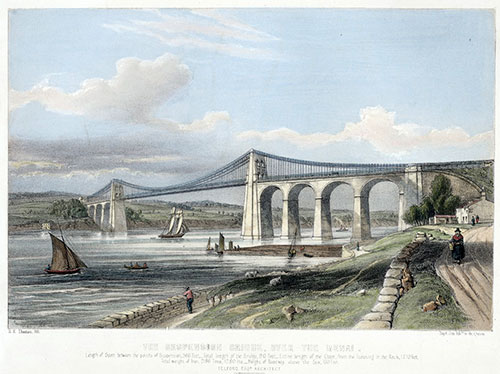Backdrops
A 19th Century Marvel of Engineering

Image courtesy of Wikimedia Commons.
Developments in engineering during the 19th century went hand in hand with the Industrial Revolution. Gas lighting, railroads, printing presses, steam locomotives, the jacquard loom, photography, machine reapers, vulcanized rubber, and myriad other inventions all came into being or were mechanized between 1800 and 1850.
One of the great advances came in the form of the suspension bridge. The suspension bridge is the earliest type of bridge, starting with simply a vine or two flung across a river. Perhaps surprisingly, the first modern iron chain suspension bridge was in the United States, at Jacob's Creek in Pennsylvania in 1801, rather than in Europe. Its creator, James Finley, patented the process in 1808. Two suspension bridges followed in England in 1817 and 1820. On their tour of Britain in 1850, Edward and Orra Hitchcock were impressed by the Menai Bridge, constructed in Wales starting in 1819 and completed in 1826 using techniques developed by Finley for the bridge at Jacob's Creek.
Suspension bridges became popular because they can span greater distances with less material and therefore less weight. The Menai Bridge used chain cables, but it was discovered that thin strands of steel bundled into a cable were stronger than chains, which also reduced the weight of the structure. In 1845, construction of the Britannia Bridge was started within sight of the Menai in order to carry trains. It opened in March 1850, just two months before the Hitchcocks arrived.